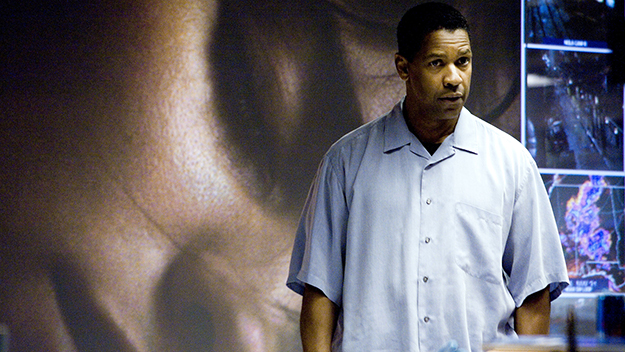Seeing Double: Déjà Vu & All Light, Everywhere
This article appeared in the August 19 edition of The Film Comment Letter, our free weekly newsletter featuring original film criticism and writing. Sign up for the Letter here.

Déjà Vu (Tony Scott, 2006)
Somewhere in the interminable spiral that was the past year and a half, I finally got around to watching the alternately despised and beloved Tony Scott time-travel action-thriller Déjà Vu (2006). Later, just after this summer’s more conclusive return to theaters, I stepped into IFC to catch Theo Anthony’s semi-experimental surveillance documentary All Light, Everywhere. Seeing the two in quick succession, I realized that Anthony’s doc features a segment about a real-life surveillance device that is almost comically close to Déjà Vu’s central sci-fi conceit.
In the New Orleans–set Déjà Vu, Denzel Washington’s Special Agent Douglas Carlin is caught up in a time-twisting chase centered around a device called “Snow White” that allows a user to look 4 days, 6 hours, 3 minutes, 45 seconds, and 14.5 nanoseconds into the past using satellite images that record all happenings in the city. Anthony’s film, structured as a triptych, focuses in part on an actual spy plane, developed by Persistent Surveillance Systems (yup, they really named themselves that) and operated by the Baltimore Police Department, that photographs and records all activity below. The images collected can be scanned through and zoomed into later. During the revolutionary summer of 2020, the plane was secretly deployed over Baltimore to surveil Black Lives Matter protesters.
Both Scott and Anthony turn the cameras at the center of their films into formal devices that dramatize the editing process of film narrative. Anthony’s film shows us how the spy plane allows police officers to play the same role as a film editor with nearly limitless choice of footage, giving them the ability to select which story beats from the round-the-clock high-resolution sky footage of the city to edit into a narrative. The owner of Persistent Surveillance Systems shows us how his camera can track an individual car, and argues that it should be deployed over “high-crime” areas—which are, of course, also majority-Black ones. A community organizer wisely points out that this enacts a vicious cycle, reinforcing existing racial biases and presumptions of criminality which further facilitate the hyper-policing of Black communities. Anthony acknowledges that his film operates in a similar way but for different ends: as a documentary filmmaker, he pulls chunks out of the world to make his own case, which is an indictment of omniscient surveillance culture. The question he poses, both implicitly and explicitly through his voiceover, is: what is the work of a documentary camera, when such cameras are so often used as means of state repression?
Déjà Vu ups the formal ante considerably by making its time-traveling camera a handheld device that allows the person wielding it to see into the past from their own point of view. This frame-within-a-frame makes for some truly deranged chase scenes, as Carlin uses the camera to track a car in the past while driving the same route in the present. Scott integrates the two timelines into a single frame, reminding us that every camera is always looking from a specific—and always incomplete—angle. (These scenes are also a good reminder that there’s no reason a film cannot be both a rigorous formal exercise and a kinetic delight.) When Snow White is later revealed to also be capable of sending a person back in time, the metaphor of the cop as film editor is made explicit. The camera becomes a means not just to capture the present but also to actively create a new sequence of events in the future. Scott envisions in an action thriller in 2006 what Anthony documents as reality in 2021.
Both Déjà Vu and All Light, Everywhere recognize that cameras, no matter how “objective,” eventually end up in the hands of humans, and that their images are seen and interpreted by viewers, whether in a courtroom or a multiplex. Déjà Vumakes this dynamic and literal, while All Light, Everywhere renders it in terms that are more academic. But in the end, neither film knows what to do with that fact. Pessimism, optimism, heroism, excitement, and defeat fly around these movies’ knotted forms.
The question for us as filmmakers and audiences then becomes: how might we use cameras to bear witness to—and shape—a better future? Anthony gestures toward an answer, only to shrug it off. In the film’s ending, he informs us via onscreen text that he handed out video cameras to Black students at a local Baltimore high school to see what film-worlds they might shape for themselves, but decided he couldn’t find a place for their images in his movie. In Déjà Vu, the narrative stops where it begins, returning to the boat explosion that instigated the story—only this time, the attack is foiled by Carlin via time-travel shenanigans. He is united with his love interest, who is now saved from death, and the film ends. What happens after the endings of these two movies? How can a camera envision a different future, rather than being used to recreate the biases and injustices of the past?
In my recent films, So Pretty and Marriage Story, I’ve tried to use the camera to provide glimpses of a world to come, in the same way that a 3D object can cast a shadow of a 4D object. I’ve used shreds of documentary to build fictional spaces where protagonists can suss out better ways of living together. But as global warming and the seemingly implacable world order of racism and capitalism loom ever larger, I wonder if the question of how to portray a possible future has become less theoretical and more practical than ever.
Jessica Dunn Rovinelli is a film director living in New York.







